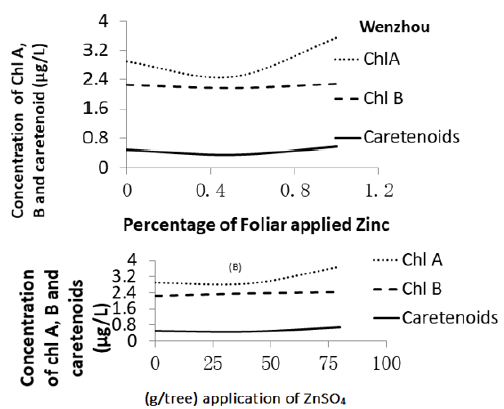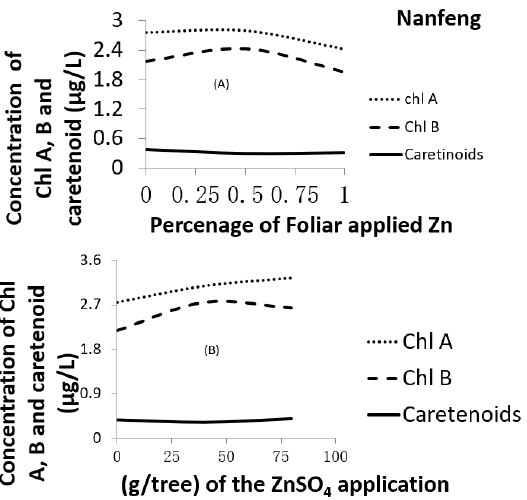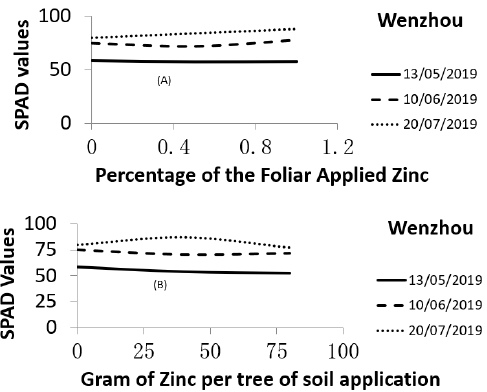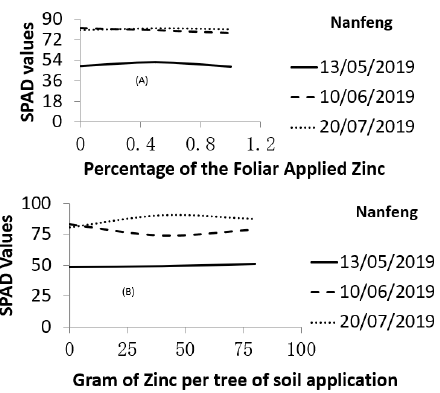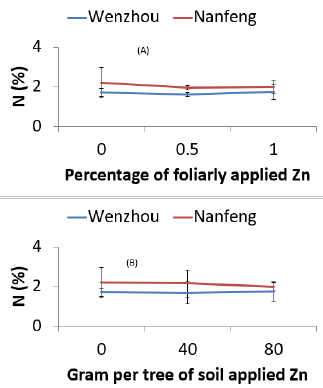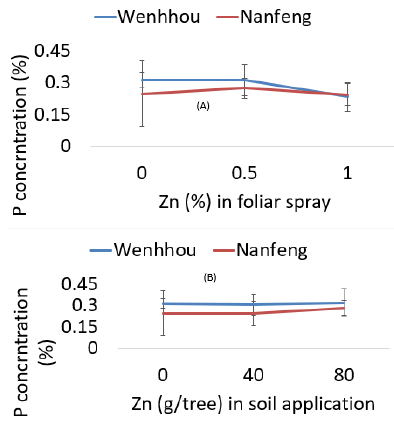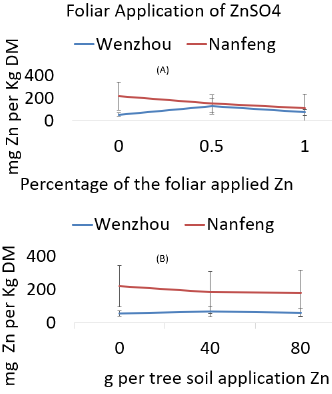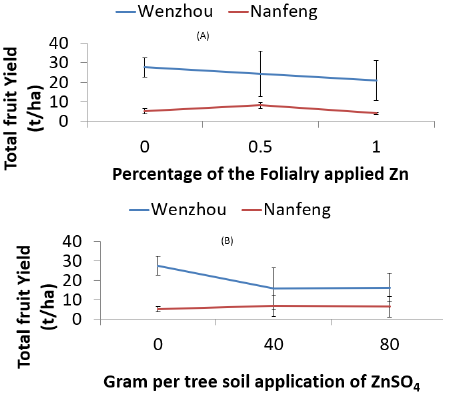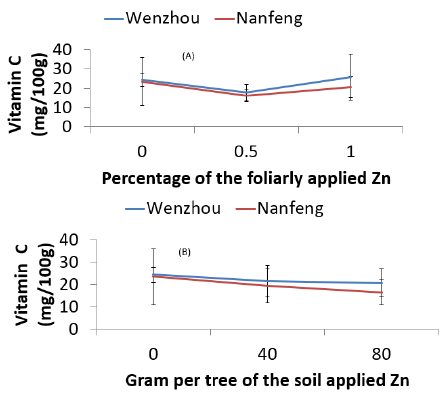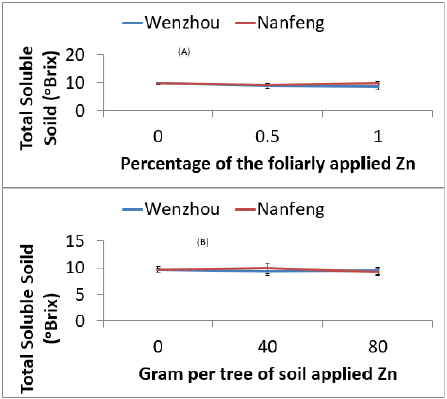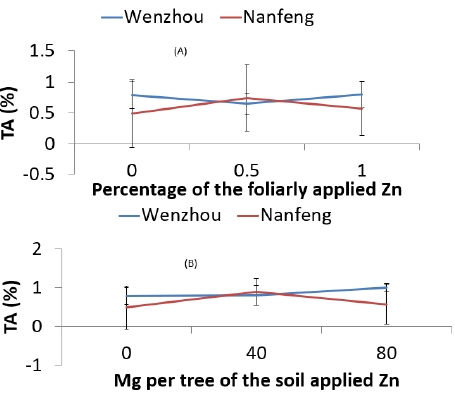ABSTRACT
Optimizing between yield and quality with judicious use of macro and micro nutrients is the goal of the present era farming. In this study major emphasis has been given to incorporation of mineral nutrition elements like N, P, K and Zn in the citrus (Citrus reticulata Blanco) varieties Wenzhou and Nanfeng respectively. Field condition prior to start of the experiment showed 22.35 mg/Kg of Zn in soil and nutrient concentration in the top leaves of these two varieties before the initiation of the treatment were Wenzhou (N- 1.72, P-0.17, K-0.30) and Nanfeng (N-2.11, P-0.16, K-0.37). Both the data aforementioned are presented in the percentages. In the variety Wenzhou an yield of 15 to 30 t/ha was recorded whereas in the variety Nanfeng 5 to 10 t/ha yield was recorded. Measurement of cholorophyll A, B, Caretenoids, SPAD values, N, P, K , Zn did not show the significant effect. Similarly, vitamin C, total soluble solids, titrable acidity are not also significant. These results revealed that the effect of plant to added ZnSO4 has response only if the Zn concentration in the soil is below critical limit. The critical limit of the Zn concenteation is above 20 mg/Kg which just marginally available. Moreover in this condition the two approaches of the biofortification i.e. foliar and soil biofortification can be adopted widely either in combined or solely. So an increased in the yield and fruit quality parameters addressed can be expected.
Keywords: Zinc; Biofortification; Foliar Application; Soil Application SPAD Value; Chlrorophyll A and B; Fruit Quality
Introduction
Gaining maximum yield and benefit with optimum use
of nutrients source is the common objective of the growers
worldwide. Most of the nutrient element are soil applied whereas
few are applied on the foliage. Soil application needs higher dose
and is more often and most effective for the nutrients (Fageria
et al. [1]). However there are few circumstances that foliar application of nutrient is more economic and effective. Application
of soil fertilizers is done on the basis of soil test where as foliar
application is done on the basis of visible cues or detailed plant
tissue examination. So correct diagnosis of the nutrient deficiency
is the fundamental for the successful foliar fertilization (Fageria, et
al. [1]). Moreover some peculiar traits which are required for foliar
application of nutrient elements are higher leaf area index so as to
absorb nutrients elements instantly. The nutrient elements should
be applied more than once based on the severity symptoms. Highly
soluble fertilizer can be applied in the optimum temperature and
sunshine avoiding leaf burning. Foliar application of the fertilizer
can complement to the soil application. Such foliar application
can be sprayed in combination with insecticides, postemergence
herbicides or fungicides with increased the net benefit by reducing
the cost of application (Fageria, et al. [1]). Moreover multiple
nutrient elements such as Fe, Zn and Cu can be mixed and sprayed
together which saves both time and money (Bhantana, et al. [2]).
The growth and development of plant is enhanced by effective
application of proper amount of nutrient in the root zone. And
adverse effect on plant growth and development is appeared due
to failure to apply balanced fertilization. So not only Zn but also
each and every nutrient required for balanced fertilization i.e. an
application of macro and micro nutrient elements such as N, P, K,
Ca, Mg, S, Fe, Mn, Zn, B, Mo, Cu, Cl, Ni etc in proper amount (Kumar,
et al. [3]). Zn is an important micronutrient for plants. Zinc in soil
and plant nutrition is becoming major concern over the more than
forty different countries worldwide (Alloway [4]). Some examples
of soil which are deficient in Zn are calcareous soil, sandy soil,
tropical weathered soil, saline soil, waterlogged soil and heavy
clay soil etc. (Alloway [4]). In the soil solution there is decrease in
Zn by 30 fold with each unit increase in pH from 5- 7. When soil
pH is higher than 8 the zinc bound more strongly causing poor
availability of the Zn in soil solution (Cakmak, et al. [5]). Heavy
fertilization with nitrogen is reported to have Zn deficiency in citrus
of Florida. This is because that the application of nitrogen increases
tissues numbers and sizes and eventually increases Zn hunger, the
dilution effect. Similarly nitrogenous fertilizer increase acidity in
the soil which increases Zn availability (Swietlik [6]). So a study of
physiological response of Zn on fruit yield and quality parameters is
taken for this study. Lack of Zn supplementation in daily diet is the
major issue for the health of the global citizen (Bhantana et al. [2]).
In the present scenario more than 1.1 billion people are suffering
from lack of Zn nutrition (Kumssa, et al. [7]). Zinc can be applied
to the soil or foliage respectively. There is a huge gap between
the Zn supply and Zn requirement. Combined application of both
soil and foliar application of Zn is practiced from the time ahead
to minimize the gap (Bhantana et al. [2]). Inadequate supply of Zn
in human food cause to lead several symptoms. Major symptoms
of the Zn deficiency are growth retardation, delayed sexual and
mental development, eczema and hair loss (Barokah, et al. [8]). And
it is also reported that about 300 proteins in the human body are Zn
dependent (Krezel, et al. [9]).
Some agronomic, breeding and biotechnological aspect of
biofortification are essential to acquire the diversification of food.
Monoculture is the key aspect of the reduced Zn fortification
to the crop and their final product. Similarly people in the
developing countries are highly dependent on plant based food
rather than animal based diets (Cakmak, et al. [5]). A gap between
daily requirement (40-50 mg Kg-1) and supplement (20 mg Kg-
1) is observed (Cakmak, et al. [5]). This is how an agronomic
biofortification of cereals and fruits needs to be done. In this study
both crop hunger with Zn and Zn hunger for food for the humans
is addressed. In citrus orchard Zn is the most frequently occurring
nutritional disorder. This is how two conventional used methods
soil and foliar application are concurrently practiced. After N, Zn is
the most widespread nutritional element frequently threatening the
citrus industry. Both flowering and fruit set are affected by the Zn
fertilization. Superiority of foliar application over soil application
increase the fruit number and weight (Srivastava [10]). So both
the methods and amount of application of Zn pertains importance
over citrus quality and production (Razzaq, et al. [11]). Use of foliar
spray with 0.6% increase tree height, crown width and stem girth.
Also fruit diameter, fruit weight, vitamin C and total phenolics is
increased in treated plant than untreated (Razzaq, et al. [11]).
Hence the use of soil or foliar application solely in agreement to the
field condition is practiced in this research. This is how this project
is specially focused to deal with crop hunger and human hunger for
the Zn.
Materials and Methods
The research was carried out in the Huazhong Agricultural University (HZAU; 30°28′26″N, 114°20′51″E), Wuhan, China. A study on the response of foilar cum soil biofortification of Zn on citrus trees was done in the two varieties namely Wenzhou and Nanfeng in the five year old orchard. Similarly the SPAD (Soil Plant Analysis Development) value of the five leaves per tree were measured as described in the (Ling, et al. [12]). Twenty seedlings of ‘Wenzhou’ and ‘Nanfeng’ each were planted in the plant nutrition research block in the year 2014. The treatment consisted of three different levels of Zn application. The three different concentrations of foliar Zn application were 0, 0.5 and 1.0 percentage and the three different concentration of soil applied Zn were 0, 40 and 80 g/tree. Chlorophyll concentration, including Chlorophyll A, Chlorophyll B and caretenoids were measured by treating with 95% ethanol based on the following equation with spectrophotometric observation (Sumanta, et al. [13]).

Similarly the data on SPAD was measured on three different dates 13 May 2019, 10 June, 2019 and 20 July 2019. For the determination of NPK concentration in plant samples, plant samples were dried in forced air oven at 70oC to constant weight. Grinding and sieving of dried samples were done through 0.5 mm screen. 0.12g of finely grounded samples were mixed with 5ml of sulphuric acid (H2SO4) and wait for 12 hour for digestion. Then the samples were digested in digestion system of fume hood. The samples were heated to 180oC for 3 hour with addition of H202. After fully digested samples to clear white are transferred to 50 ml volumetric flask and dilute to 50 ml with deionized water. The Barbano and Clark 1990; method is used for the determination of N by using Kjeldahl apparatus. Similarly, colorometric method (Lu, [14]) was used to determine the concentration of P after digestion of the plant samples in H2SO4-H2O2. Moreover flame photometric technique was used for the determination of K in plant samples after the samples were completely digested in H2SO4-H2O2. The digested solution were distillated, filtrated and transferred to 50 ml volumetric flask and diluted to 50 ml with deionized water. The Zn in plant tissue in this study was determined by DTPA (Diethyltriamine pentaacetic acid) extraction-atomic absorption spectrophotometer method as described in (Katyal, et al. [15]). Similarly the vitamin C was measured by titration with 20% oxalic acid as quoted in (Najwa, et al. [16]) and hand held refractrometer was used for the measurement of total soluble solids as described in Echeverria, University of Florida, IFAS. Similarly titrable acididty was measured by titration of fruit juice with NaOH as described in the (Islam, et al. [17,18]).
Results
Figure 1: Microgram per litre (μg/L) concentration of chlorophyll A, Chlorophyll B and caretenoids in varying level of Zn
application
(A) Foliar application and
(B) Soil Application in the variety Wenzhou.
The determination of chlorophyll A, chlorophyll B and caretenoids of the variety Wenzhou are shown in the –(Figures 1A-1B)) with foliar spray of 0, 0.5 and 1 percentages and soil application of 0, 40 and 80 g/tree ZnSO4 respectively. In both figure Chlorophyll A is appeared on the top, Chlorophyll B in the middle and caretenoids in the bottom. Similarly, the determination of chlorophyll A, chlorophyll B and caretenoids of the variety Nanfemg are shown in the (Figures 2A-2B)) with foliar spray of 0, 0.5 and 1 percentages and soil application of 0, 40 and 80 g/tree ZnSO4 respectively. Again in the both figures Chlorophyll A is appeared in the top, Chlorophyll B in the middle and caretenoids in the bottom. The concentration of chlorophyll A, chlorophyll B and caretenoids in Wenzhou and Nanfeng as expressed in μg/L showed similar results. The data on soil plant analysis development (SPAD) is shown of in the Figures 3 & 4. The data were recorded in three different dates 13-May, 10-June and 20-July 2019 respectively. More mature the leaf the higher the reading of the SPAD. These SPAD values were arranged in ascending order 13-May, 10-June and 20-July. Besides the SPAD values in two varieties of citrus was observed similar. Also it appeared that the SPAD values observed similar with foliar application 0, 0.5 and 1 percentages and soil application of 0, 40 and 80 g ZnSO4 per tree (Figures 3 & 4). In most of the cases on an average the value of SPAD varied between 40-85. There is no distinct variation in SPAD values with foliar application of ZnSO4 0, 0.5 and 1% and soil application of ZnSO4 0, 40 and 80 g/tree respectively. Based on the chlorophyll measurement (Figures 1 & 2) and SPAD value (Figures 3 & 4) and that there is not a significant variation in Wenzhou and Nanfeng. Similarly there is no difference between foliar application and soil application of ZnSO4 in this attributes. Percentages of N, P, K with application of Zn as foliar spray or soil application is shown in the (Figures 4A & 4B)) of the respective (Figures 5-7) respectively. The concentration of nitrogen is higher in Nanfeng than Wenzhou in the parameter N in the study (Figure 5). Conversely the parameter Wenzhou is higher than Nanfeng in the parameter P study (Figure 6).
Figure 2: Microgram per litre (μg/L) concentration of chlorophyll A, Chlorophyll B and caretenoids in varying level of Zn
application.
(A) Foliar application and
(B) Soil Application in the variety Nanfeng.
Figure 3: SPAD values recorded in varying levels of Zn application
(A) Foliar application and
(B) Soil Application in the variety Wenzhou.
Figure 4: SPAD values recorded in varying levels of Zn application
(A) Foliar application and
(B) Soil Application in the variety Nanfeng.
Figure 5: Percentages of N recorded in varying levels of Zn application
(A) Foliar application and
(B) Soil Application in the variety Wenzhou and Nanfeng.
Figure 6: Percentages of P recorded in varying levels of Zn application
(A) Foliar application and
(B) Soil Application in the variety Wenzhou and Nanfeng.
Moreover an interaction between Wenzhou and Nanfeng is observed in the (Figure 7) with percentages of K application. When the values of Nanfeng is higher the Wenzhou is lower and vice versa. As shown in all the figures from (Figures 1 & 7) that there is no significant difference in between Nanfeng and Wenzhou varieties. Similarly, the mg of Zn per Kg DM is shown in the (Figure 8). Both in the foliar application and the soil appliation, the Zn content in the Nanfeng is higher than Wenzhou. In the (Figure 8), it seemed a weak interaction between these two varieties for the parameter Zinc concentration. At zero concentration the Nanfeng has higher value of Zn supply than Wenzhou and other higher concentrations for example at 0.5 and 1 percentages of the foliar spray or 40 and 80 g/tree of soil application of ZnSO4. Likewise total fruit yield t/ ha is shown in (Figure 9). The fruit yield varied between 30-10 t/ ha in Wenzhou and it varied between 10-5 t/ha in Nanfeng. Also the vitamin C content in relation to the soil and foliar application in the foliar versus soil application of Zn is shown in the (Figure 10). However the analyzed data are not significant the value of vitamin C is higher in case of the variety Wenzhou than Nanfeng. It is observed that at zero concentration of foliar application of ZnSO4 and at Zero concentration of soil application the vitamin c amount is higher than other amount. Even more the total soluble sugars (TSS) is presented in the (Figure 11). The data are not statistically significant the presented values are similar with the application of foliar or soil applied Zn. Last but not the least another parameters for the study of Zn response is titrable acidity (TA). There is interaction between two varieties for the TA. In the variety Nanfeng there is higher value of TA with application of 0.5% foliar applied Zinc and 40 g/tree application of ZnSO4. In the variety Wenzhou the response soil cum foliar application in TA of Zn is the straight line (Figure 12).
Figure 7: Percentages of K recorded in varying levels of Zn application
(A) Foliar application and
(B) Soil Application in the variety Wenzhou and Nanfeng.
Figure 8: Milligram of Zn per Kg dry matter recorded in varying levels of Zn application
(A) Foliar application and
(B) Soil Application in the variety Wenzhou and Nanfeng.
Figure 9: Total fruit yield (t/ha) recorded in varying levels of Zn application
(A) Foliar application and
(B) Soil Application in the variety Wenzhou and Nanfeng.
Figure 10: Vitamin C (mg/100g) recorded in varying levels of Zn application
(A) Foliar application and
(B) Soil Application in the variety Wenzhou and Nanfeng.
Figure 11: Total soluble solids (oBrix) recorded in varying levels of Zn application
(A) Foliar application and
(B) Soil Application in the variety Wenzhou and Nanfeng.
Figure 12: Titrable Acidity (%) recorded in varying levels of Zn application
(A) Foliar application and
(B) Soil Application in the variety Wenzhou and Nanfeng.
Discussion
Micronutrient like Zn plays pivotal role in the growth and
development of plant and occupy an important position due to its
essentiality (Dewal, et al. [19]). Even more the role of Zn in plant
nutrition and increasing soil productivity increase the importance
greater. With regards to increase cropping intensity, intensive
cropping with high yielding crop and their varieties even increasing
the importance of the micronutrient like Zn in agriculture (Dewal,
et al. [19]). The present era farming is highly focused to top yield
and quality so the attempt has to be paid for the application of Zn.
An emphasis in soil or foliar application or combined application of
Zn enhanced plant growth, grain yield and the components of grain
quality. Zn is an essential attribute of the plant hormones, green
chlorophyll and cytochrome (Dewal, et al. [19]). Similarly Zinc is
one of the key nutrient element for the growth and production of
plant. It helps in the production of chlorophyll pigment in the crop.
There are instances to which production of chlorophyll, caretenoids
and increase in yield and quality is achieved by application of Zn
(Kandoliya, et al. [20]). For example increase in the chlorophyll is
achieved at 45 and 70 days after sowing (DAS) (Kandoliya, et al.
[20]). Not only foliar application also soil application of Zn increase
the grain yield, protein and gluten content of wheat. This is due to
increased photosynthesis with the help of increasing leaf pigment
and enhanced mineral nutrition (Kandoliya, et al. [20]). The highest
Zn content in straw and grain is recorded in chelated Zn treatments.
Regarding plant nutrition content the chelated Zn appeared highest
than the soil application. Similarly, the use of foliar spray increased
the fertilizer use efficiency and wheat nutrient content (Kandoliya,
et al. [21]).
But in this research as shown in Figures 1 & 2, the chlorophyll A,
Chlorophyll B and Caretenoids did not differ in relation to soil and
foliar application of the nutrients. Both variety used in the study
showed similar response for the chlorophyll A, chlorophyll B and
caretenoids (Kandoliya, et al. [21]). SPAD stands for the soil plant
analysis development. SPAD is a hand held device used for the rapid,
accurate and non-destructive measurement of leaf chlorophyll
concentrations. SPAD is used extensively both in the research and
agricultural operation with a range of plant species (Ling, et al. [12]).
There are a number of scientific papers published in the area of using
SPAD measurement (Uddling, et al. [22]). The SPAD meter (Konica-
Minolta, Japan) provides alternative to the data provided through
the destructive measurement of ethanol based formulation of leaf
chlorophyll as shown in the Figures 1 & 2. This alternative method
accounts for overcoming the disadvantages of leaf chlorophyll
measurement. SPAD is a tool not very expensive, hand held device
based on two light-emitting diodes. Measurement of a silicon
photodiode receptor with the measurement of leaf transmittance in the red 650 nm wavelength and 940 nm. The transmittance values
are used to derive the relative SPAD meter value are in between 0-50
which is proportional to the chlorophyll concentration in the leaf
sample (Uddling, et al. [22]). But in our case the SPAD values varied
between 40-80. The recording of the SPAD value differed by the
age of the leaf, solar radiation, time of the day, cloudiness etc. Leaf
chlorophyll concentration is an important parameter that frequently
measures as an indicator of chloroplast development, nitrogen
content, photosynthetic capacity or plant health. As mentioned
in the (Figures 1 & 2), leaf chlorophyll is destructively quantified
in the laboratory. Leaf chlorophyll concentration is an important
parameter which correlated with SPAD readings in this study. So in
vivo measurement of chlorophyll by SPAD should be focused. Yield
and quality of the citrus fruit are subjected to balanced fertilization.
New shoots in citrus are correlated with fruit yield. Citrus leaves
accounts for 21% and 31-44 % of the above ground biomass and
above ground nutrients respectively (Roccuzzo, et al. [23]). Earlier
study showed distribution of N in different parts of the citrus such
as shoots, leaves and fruits (Roccuzzo, et al. [24]). Measurement of
the top shoot leaf nitrogen prior to start of the experiment is 1.72%
(Wenzhou) and 2.11% (Nanfeng) (Unpublished data). Similarly in
the study after application of Zn varied in between 1.18 to 2.25 in
both of the varieties either with the application of foliar nutrition or
soil. Mineral nutrients composition in the citrus fruits is optimized
by application of balanced nutrition. Concentration of nutrients in
citrus fruit varied with amount of N(52.70–71.4%), P (66.5–80.4%)
and K (68.9–85.9%) (Fan, et al. [25]).
Furthermore, the nutrient requirements per unit of newly
developed shoots and fruits were gradually decreased and increased.
These information is useful for the pruning and fruit thinning of
the citrus orchard (Fan, et al. [25]). Moreover, the concentration
of N and K is increased highly in the citrus fruit. Whereas the P is
required for the tree growth (Zambrosi, et al. [26]). As presented
in the (Figure 5). the concentration of N is higher in the variety
Nanfeng in comparison to Wenzhou. The value of N percentage is
significant at 0.5% of the foliar application than Wenzhou as shown
in the (Figure 5A). In addition an alternate bearing is closely looked
and the citrus tree fetched great amount of nutrition which is still
unresolved (Martinez-Alcantara, et al. [27,28]. China is one of the
key producers of citrus but still there is problematic situation due
to low yield, excessive fertilization and alternate bearing. Practice
of rational fertilization, quantification of new tissues, nutrient
demand rules are suggested for the improvement. Moreover high
and stable yield, and high citrus quality in citrus plantation can
be achieved (Li, et al. [29]). Application of 180 lb N ac-1yr-1 is
recommended to sustain optimal tree growth, maintain high fruit
quality and production in the citrus orchard of the Florida (Alva,
et al. [30]). The rate, placement and timing is essential to meet the
proper application of the fertilizer. Also organic sources of nutrient
for example the leaf litter can be incorporated as fertilizer. However
the leaf analysis showed important parameter for the evaluation of
nutritional status of the trees an identification of the nutrient budget
is important. Measurement of nutrient budget is one of the way to
the fertilizer recommendation for the nutrient uptake efficiency
(Alva, et al. [30]). The composition of mineral nutrients for example
N, P and K in the fruits varied from 1-1.19, 0.14-0.16 and 1.19 to
1.26 respectively (Alva, et al. [31]). The citrus production is higher
than other tropical and subtropical fruits including Banana, Mango,
Apple , Pear and Peach (Alva et al., 2006). China alone occupies the
highest production of citrus fruit in the world (Li, et al. [29]). Citrus
production is mainly suited to sandy to clay loam soil. Soil pH of
6.0 is optimal for citrus production however the pH value between
5.5-7.5 is also adequate based on the different rootstock (Alva, et al.
[30]). China ranked the first in position to the production of citrus
both in the area and yield.
Citrus is one of the key commodity fruit in terms of farmers
income, industrialization, poverty alleviation and provides
occupation to needy farmers in the south China mountainous
region (Li, et al. [29]). Increment in the fruit quality parameters
namely yield and quality, vitamin C, total soluble solids, TA, etc
with increased application of N, P and K is recorded (Han, et al. [1]).
Application of urea 1.75 Kg plant-1 affect the quality of citrus fruit
increasing the content of invert sugar by 12.2% and by reducing
the vitamin C by 13.3% (Li, et al. [29]). So it has been observed that
application of P increase fruit yield but decrease total soluble solids
(Obreza, et al. [32]). Despite the numerous attempts has been paid
towards the application of N, P, K on citrus fertilization yields mainly
depend on cultivar, age, climate and soil physiochemical properties.
In Brazil increase application of P increase the yield of lemons
(Obreza, et al. [32]). Increase in the size of the fruit and number
are accredited to the increased yield in citrus fruit. Firstly balanced
fertilization application increase the number of fruits per tree and
secondly the increment in the fruit size is recorded (Li, et al. [29]).
An speculation was made towards decrease in aluminium toxicity
in the soil with an amount of surplus P fertilization (Nakagawa,
et al. [33]). P amendment increase TSS in citrus fruit. Application
of P increase the citrus yield and quality (Quaggio, et al. [34]). So
application of P increase the yield of citrus by 32.6% with increase
both in number and size of the fruit. But the mineral nutrients N
and P do not have effect on TSS (Li, et al. [29]). Due to limitation
of rootstock and plant growth; a high application for P uptake are
desirable. So an experiment was designed for the application of 20,
40 an 80 mg Kg-1 P. Increased in the root growth, shoot growth,
P nutrition by the uptake of greater number of other nutrients. In
case of Rangpur lime there is increase uptake of P by 13-126%. So P
use efficiency of citrus tree can be increased by applying the P in the deeper strata of the soil and use of better rootstock (Zambrosi, et al.
[26]). Potassium has important contribution in yield and quality of
the citrus fruit. High amount of K application increase the fruit size
and thick and coarse peel. Whereas low amount reduced the size of
the fruit with thin peel (Alva, et al. [31]). Similarly the juice acidity
is directly proportional to K concentration in the fruit. High acidity
is caused by high amount of K and vice versa. Highly available K in
soil enduce the uptake of some ions such as magnesium, calcium
and ammonium ions (Alva, et al. [31]). The concentration of K in
leaf tissue varied between 0.30 to 0.37% before initiation of the
treatment (Data not shown). But after initiation of the treatment the
value changes to 0.4 to 0.8% in the variety Wenzhou and Nanfeng
respectively (Figures 7A & 7B)) in foliar cum soil application of
nutrients.
These figures are quiet similar to the data observed in this
study. In combined application of 1% urea and 0.8% Zinc sulphate
in a every two week interval applied for six year increase the yield
and quality of 15 year old apple trees. Increase in yield is solely
due to the increase in the mean fruit size (Amiri, et al. [35]). The
highest yield observed is 49 Kg/tree with the maximum fruit size
(202g). Whereas the lowest yield recorded was 35 Kg/tree with
the maximum fruit size 175 g (Amiri, et al. [35]). Lower record of
the fruit in the control treatment is due to pre-harvest fruit drop
and smaller size of the fruit. As shown in the (Figure 9A); in this
study the fruit yield varied from 30 to 15 t/ha in Wenzhou and 5 to
15 t/ha in Nanfeng respectively in the foliar application. But in the
(Figure 9B) with soil application of Zn fertilizer increased the yield
in Wenzhou to 15-35 t/ha. These Figures also showed the fruit yield
in the Nanfeng with foliar or soil application of Zn. The differences
in the yield observed is varietal and has not any relation with the Zn
application under both soil and foliar application. The concentration
of P in top shoot samples prior to start of the experiment are 0.17
and 0.16% in the top shoots of oranges respectively (unpublished
data). And in the current study the P concentration varied between
0.15-0.35% respectively. The amount of vitamin C quantified in the
concentration of mg per 100 g of fruit is presented in the Figure
10. The vitamin C is measured with titration method. As shown in
the Figures 10A & 10B, the vitamin C ranges from 10-25 mg/100 g
of the fruit. According to the Najwa and Azrina, 2016, the vitamin
C content of the orange, grapefruit, lemon, kaffir lime, lime and
musk lime are 58.3, 49.15, 43.96, 37.24, 27.78 and 18.62 mg per
100g respectively. The finding of our research is below than the
aforementioned value except in musk lime. However the different
method used in the determination has different values for the
vitamin C. The use of HPLC method is closely suited to our values
as determined by (Najwa, et al. [36]). In the HPLC the 43.61, 31.33,
26.4, 22.36, 21.58 and 16.78 mg/100 g of orange, lemon, grapefruit,
lime, kaffir lime and musk lime is observed respectively. Significant
variation is observed in the study of vitamin C of samples by both
methods. Both of the methods are suitable for the determination of
vitamin C, however the HPLC method is more accurate, precise and
specific (Najwa, et al. [36]).
TSS value as measured by the hand refractrometer is shown in
the Figure 11. Similarly the value of TA is shown in the Figure 12 by
titration with 0.1 N sodium hydroxide solution and phenolphthalein
indicator (Suszek, et al. [37]). Total fruit yield ranges from 2.04 to
11.70 Kg/tree in the year 2009 and 5.52 to 32.94 Kg/tree in the year
2010 (Suszek, et al. [37]). Occurrence of drought spell in flowering
and fruiting time may cause the difference in the yield. Smaller size
of the fruit in the year 2009 cause lower yield. The average size of
the fruit as observed was 323g and 310g respectively in the year
2010 and 2009 respectively. The value of TSS in the year 2009 is
6.23 to 8.65 oBrix and in the year 2010 is 6.18 to 9.11 oBrix (Suszek,
et al. [37]). These values are close to the values presented in the
(Figure 11). Similarly the value of titrable acidity (TA) as observed
in this study is shown in the Figure 12. The TA value ranges from
0.53-0.99 % in the year 2009 and 0.40-0.71 % in the year 2010
(Suszek, et al. [37]). These values are in close connection with the
data presented in the (Figure 12). Soil Zn concentration measured
by DTPA method in mg per kg dry matter is 22.35 (unpublished
data) before start of the experiment. This value is higher than the
critical value of the Zn in soil. So the plant do not experience Zn
deficiency in the treatment. As shown in Figure 9, the yield of two
varieties as known as Wenzhou and Nanfeng under foliar as well
as soil application of Zn do not differed each other. Symptoms of
chlorosis is appeared in some instances but not so severe. So there
is no significant difference in the foliar cum soil application of Zn
in this study. Based on the feasibility farmers are recommended to
choose foliar application Zn than soil application. Since there is not
significant variation in the yield and yield attributing parameters in
these two treatment in the citrus trees of Wuhan.
Conclusion
Zinc is not only an essential nutrient element but also a heavy metal. So, in spite of the ameliorating effect, Zn has a deleterious effect when applied in excess. This is how due care has to be paid for the successful incorporation of Zn in cropping system. Soil test values are required to judge the concentration of the Zn in soil. Similarly the evaluation of Zn in plant tissue are required. However Zn value differed from soil types, plants and their varieties and crop growth stages. The critical limit for the Zn concentration from the soil in Wuhan, China is 22.35 mg Kg-1. So attention has to be paid for successful incorporation of Zn in an agro ecosystem. In regards to the critical limit research has to be carried out more frequently to access the ground reality in connection with the published literature. Moreover fruit yield and quality like vitamin C, total soluble solids, titrable acidity etc are increased with the application of Zn in different crops grown. So the human demand for Zn and crop hunger can be satisfied (Krezel, A et al. [38]).
Conflict of Interest
The authors declares that there is no conflict of interest.
Acknowledgement
Special thanks to my brother Ishwor Bhantana, his wife Kopila Pokhrel Bhantana and their only son for hosting my stay in Kathmandu during the write up. Despite the incidence of COVID-19 my wife Sita Paneru Bhantana responded normally to me. Also many many thanks to daughter Alaka Bhantana and Son Alak Bhantana. I pass my gratitude to my father Rudra Prasad Bhantana and mother Nani Maya Bhantana for their blessings and eternal love.
References
- Fageria NK, Barbaso Filho MP, Moreira A, Guimares CM (2009) FoLi D, Li X, Han Q, Zhou Y, Dong J, Duan Z, Phosphorus application improved the yield of citrus plants grown for three years in an acid soil in the Three Gorges Reservoir Area Scientia Horticulturae Fertilization of Crop Plants. JPlant Nutri 32(6): 1044-1064.
- Bhantana P, Timlin D, Rana MS, Moussa MG, Zhihao D (2020) How to Cut Down The Gap Between The Zn Requirement and Supply of Food Chain and Crop Growth A Critical Review. Int J Plant Anim Environ Sci 10(1): 001-026.
- Kumar P, Sharma S, Dalal RS (2012) Citrus decline in relation to soil plant nutritional status-a review. Agricultural Re sources 33(1): 62-69.
- Alloway BJ (2008) Zinc in soils and crop nutrition (2nd) International Zinc Association and International Fertilizer Industry Association Brussels 7(6).
- Cakmak, I Kutman, UB (2017) Agronomic biofortification of cereals with Zinc: A review. Europ J Soil Sci 69(1): 172-180.
- Swietlik D (1999) Zn nutrition in horticultural crops. Hort Rev 23: 109-178.
- Bhantana P, Timlin D, Rana MS, Moussa MG, Zhihao D (2020) How to Cut Down The Gap Between The Zn Requirement and Supply of Food Chain and Crop Growth A Critical Review. Int J Plant Anim Environ Sci 10(1): 001-026.
- Kumssa DB, Joy EJ, Ander EL, Watts MJ, Young SD, et al. (2015) Dietary calcium and zinc deficiency risks are decreasing but reain Prevalent. Sci Report 5: 10974.
- Barokah U, Sustanto U, Swamy U, Djoar DW, Parjianto (2018) High Zinc rice as breakthrough for high nutritional rice breeding program IOP conf series. Earth and environmental science 129(1).
- Srivastava AK, singh S (2009) Zinc nutrition in Nagpur Mandarin on Haplustert. J Plant Nutri 32(7): 1065-1081.
- Razzaq K, Khan AS, Malik AU, Sahid M, Ullah S (2013) Foliar application of Zinc influences the leaf mineral status vegetative and reproductive growth yield and fruit quality of Kinnow mandarin. J Plant Nutri 36(10): 1479-1495.
- Ling Q, Huang W, Jarvis P (2011) Use of a SPAD-502 meter to measure leaf chlorophyll concentration in Arabidopsis thaliana. Photosynth Res 107(2): 209-214.
- Sumanta N, Haque CI, Nishika J, Suprakash R (2014) Spectrophotometric Analysis of Chlorophylls and Carotenoids from Commonly Grown Fern Species by Using Various Extracting Solvents. Res J Chem Sci 4(9): 63-69.
- Lu R (1999) Analytical methods of soil agrochemistry. China Agricultural Science and Technology Publishing House Beijing China 5(6): 18-99.
- Katyal JC, Sharma BD (1991) DTPA-extractable and total Zn, Cu, Mn, and Fe in Indian soils and their association with some soil properties. Geoderma 49(2): 165-179.
- Najwa FR, Azrina A (2017) Comparison of vitamin C content in citrus fruits by titration and high performance liquid chromatography (HPLC) Methods. Int Food Res J 24(2): 726-733.
- Islam MK, Khan MZH, Sarkar MAR, Absar N, Sarkar SK (2013) Changes in acidity TSS and sugar content at different storage periods of the post harvest mango (Mangifera indica L.). influenced by Bavistin DF. Int J Food Sci.
- Suszek G, de Souza ED, Nobrega LHP, Pacheco F, Cruz silva, CTA (2016) Use of yield and total soluble solids total titrable acidity ratio in orange on group definition for standard DRIS. Rev Bras Frutic 39(4): 876.
- Dewal GS, Pareek RG (2004) Effect of phosphorous, sulphur and zinc on growth yield and nutrient uptake of wheat (Triticum aestivum L.). Int J Agron 49(3): 160-162.
- Kandoliya RU, Sakarvadiya HL, Kunjadiya BB (2018) Effect of zinc and iron application on leaf chlorophyll, carotenoid grain yield and quality of wheat in calcareous soil of Saurashtra region. Intl J Chem Stud 6(4): 2092-2096.
- Kandoliya RU, Kunjadia BB (2018) Effect soil and foliar application of zinc and iron on micronutrients uptake by wheat in calcareous soil. European J Biotech Bioscience 6(4): 65-69.
- Uddling J, Gelang Alfredsson J, Piikki K, Pleijel H (2007) Evaluating the relationship between leaf chlorophyll concentration and SPAD 502 chlorophyll meter readings. Photosynth Res 91(1): 37-46.
- Roccuzzo G, Zanotelli D, Allegra M, Giurida A, Torrisi BF, et al. (2012) Assessing nutrient uptake by field grown orange trees. Eur J Agron 41(41):73-80.
- Roccuzzo G, Scandellari F, Allegra M, Torrisi B, Stagno F, et al. (2017) Seasonal dynamics of root uptake and spring remobilisation of nitrogen in field grown orangetrees. Sci Hortic 226: 223-230.
- Fan Z, Xiong H, Luo Y, Wang Y, Zhao H, et al. (2020) Fruit Yields Depend on Biomass and Nutrient Accumulations in New Shoots of Citrus Trees. Agronomy 10(12).
- Zambrosi FCB, Mesquita GL, Tanaka FAO (2013) Assessment of leaf ultrastructure offers insights into mechanisms regulating sugarcane performance under low phosphorus stress. Acta Physiol Plant 42(2): 1-7.
- Martinez Alcantara B, Iglesias DJ, Reig C, Mesejo C, Agusti M, et al. (2015) Carbon utilization by fruit limits shoot growth in alternate-bearing citrus trees. J Plant Physiol 176: 108-117.
- Martínez Fuentes A, Mesejo C, Muñoz Fambuena N, Reig C, González Mas MC, et al. (2013) Fruit load restricts the flowering promotion effect of paclobutrazol in alternate bearing Citrus spp. Sci nHortic 151: 122-127.
- Li D, Li X, Han Q, Zhou Y, Dong J, et al. (2020) Phosphorus application improved the yield of citrus plants grown for three years in an acid soil in the Three Gorges Reservoir Area. Scientia Horticulturae 273: 109596.
- Alva AK, Paramasivam A (1998) An evaluation of nutrient removal by citrus fruits. Reprint Fla State Hot Soc 38(4).
- Alva AK, Jr MattosD, Paramasivam S, Patil B, Dou H, et al. (2006) Potassium Management for Optimizing Citrus Production and Quality. Intl J Fruit Sci 6(1): 3-43.
- Obreza TA, Rouse RE, Morgan KT (2008) Managing Phosphorus for Citrus Yield and Fruit Quality in Developing Orchards. Hort Sci 43 (7):2162-2166.
- Nakagawa T, Mori S, Yoshimura E, (2003) Amelioration of aluminum toxicity bypretreatment with phosphate in aluminum tolerant rice cultivar. J Plant Nutr 26(3): 619-628.
- Quaggio JA, Mattos D, Cantarella H (2006) Fruit yield and quality of sweet oranges affected by nitrogen phosphorus and potassium fertilization in tropical soils. Fruits 61(5): 293-302.
- Amiri ME, Fallahi E, Golchin A (2008) Influence of Foliar and Ground Fertilization on Yield, Fruit Quality, and Soil, Leaf fand Fruit Mineral Nutrients in Apple. Journal of Plant Nutrition 31(3): 515-525.
- Najwa F, Azrina A, (2016) Comparison of vitamin C content in citrus fruits by titration and high performance liquid chromatography (HPLC) methods. Intl Food Res J 24(2): 726-733.
- Suszek G, de Souza ED, Nobrega LHP, Pacheco F, Cruz silva CTA (2016) Use of yield and total soluble solids total titrable acidity ratio in orange on group definition for standard DRIS. Rev Bras Frutic 39(4): 876.
- Krezel A, Maret W (2016) The biological inorganic chemistry of zinc ions. Archives of Biochemistry Biophysics 611: 3-19.

 Research Article
Research Article